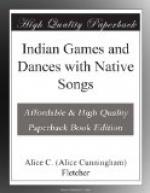Properties.—As this dance represents work, no scarfs or mantles are used. The garments should be plain and the arms free for the necessary dramatic motions in portraying the various acts connected with clearing, preparing and planting the ground. In ancient times the hoe used for this work was made from the shoulder blade of the elk, or a stick three or four feet long shaped at one end like a wedge. Similarly shaped sticks of wood should be used in this dance, one for each dancer. Pouches are required made of brown cloth, with broad bands or straps long enough to pass over the shoulder and chest and to let the pouches hang at the back. Both pouches and straps should be ornamented with geometric designs painted in red, yellow, blue or green; two or three of these colors should be combined in each design. The corn carried within the pouches can be represented by rounded chips, little stones or, when possible, by the corn kernels themselves.
The boys must wear head-bands, carry bows and have quivers hung at their backs. They must scatter around the border of the “field,” move watchfully about, peer into the distance and act as if on the alert to detect or to meet any prowling enemy.
Directions.—A space should be set apart to represent the “field” where the dramatic action takes place. This dance requires considerable dramatic pantomime. The words in the two lines of each stanza of the song serve as a prelude to the action which follows. Sometimes the action may be confined to the refrain, but generally there must be acting throughout the singing both of the words and the refrain. Much in this dance must be left to the imagination and skill of the group of dancers, who should rehearse together and decide how best to make a clear, strong picture. The native music here given belongs to the act of preparing the ground and planting the kernels of corn. Attention is called to the second, fourth, sixth and eighth measures of the song. The three-quarter notes and the eighth and rest should be accented by movements of the hoe, the foot or both. The rhythm of the first measure is a little different from that of the third, fifth and seventh, caused by the third note being a quarter note, denoting a definite act or pause; the remaining four notes of the first measure are flowing, as well as all the notes of the third, fifth and seventh measures. By observing these little points in the music the drama will be given variety and made more picturesque and effective.
At the beginning of the song the dancers should be at a little distance from the space set apart to represent the “field,” so that they will be able at the proper time to go toward it. As the first line of the first stanza is sung the dancers should stand in a loose group, adjust their hoes and pouches to be ready to go to the “field”; during the singing of the second line they should break into a file and move off. All these movements of body, hands and feet must be in strict time and rhythm with the music.




